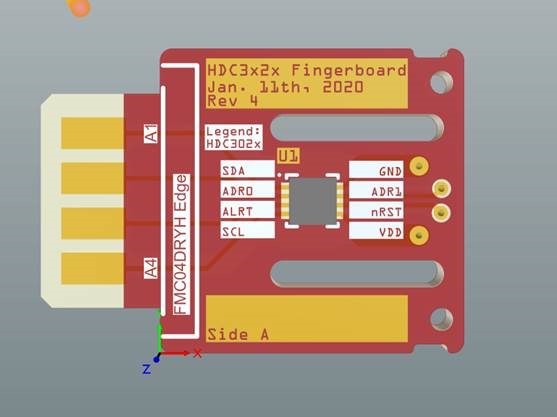SNAU265C june 2021 – july 2023 HDC3020 , HDC3020-Q1 , HDC3021 , HDC3021-Q1 , HDC3022 , HDC3022-Q1
3.5.1 Offset Error Correction Example With a Fingerboard
The fingerboard was designed for test and characterization purposes. The fingerboard has a dimension of 677 mils x 942 mils (17.2 mm x 23.9 mm) and an overall thickness of 62 mils (1.6 mm). The fingerboard has two cutouts (approximately 55 mils, or 1.4 mm) on either side of the DUT which makes this a good layout to verify the offset error correction algorithm. They are made with Rogers RO4350B dielectric (instead of FR4). The thermal pad is soldered down, but the thermal pad itself is not grounded, it’s just a floating copper pad. However, even with these cutouts, the board itself is pretty thick which led to some heat rise challenges during this process. If a user wants to design a board similar to this, ensure that the board is not too thick.
 Figure 3-7 HDC3020 Fingerboard.
Figure 3-7 HDC3020 Fingerboard. Table 3-3 and Table 3-4 show the look up tables for the HDC3020 fingerboard. The LUT was generated using 30 HDC3020 devices and were tested between 15°C – 30°C in increments of 5°C and between 10% – 45% RH in increments of 2.5%RH. The look up tables here were generated at 3.3 V and 5 V, and both were operated at the full power setting. Al the devices were placed in the chamber and the temperature rise was calculated for each temperature and humidity set point.
Temp [°C] %RH | 15 | 20 | 25 | 30 |
|---|---|---|---|---|
10 | 32.99248 | 30.94213 | 31.77977 | 31.92152 |
12.5 | 34.57237 | 32.34282 | 33.92634 | 34.64464 |
15 | 36.35748 | 34.06128 | 36.43301 | 37.84657 |
17.5 | 38.29194 | 36.10141 | 38.93244 | 40.86322 |
20 | 40.32502 | 38.1553 | 41.43969 | 43.36861 |
22.5 | 42.32662 | 40.32751 | 43.56603 | 45.46563 |
25 | 44.12985 | 42.3089 | 45.44633 | 46.89262 |
27.5 | 45.68952 | 44.20545 | 46.94305 | 47.7198 |
30 | 47.13836 | 45.81257 | 48.01137 | 48.39375 |
32.5 | 48.32647 | 47.2488 | 48.72053 | 48.77972 |
35 | 49.34081 | 48.5207 | 49.25917 | 48.98883 |
37.5 | 49.90921 | 49.28729 | 49.61261 | 49.08352 |
40 | 50.28725 | 49.79383 | 49.83082 | 49.05558 |
42.5 | 50.62314 | 50.11981 | 49.91169 | 49.05743 |
45 | 50.7908 | 50.33693 | 49.893 | 49.05599 |
RH [%]/Temp [°C] | 15 | 20 | 25 | 30 |
|---|---|---|---|---|
10 | 51.8946 | 50.34679 | 49.82128 | 49.10057 |
12.5 | 51.90337 | 50.78616 | 50.21534 | 49.50523 |
15 | 52.8088 | 50.78637 | 50.22602 | 49.52433 |
17.5 | 52.79793 | 50.7915 | 50.65976 | 50.00581 |
20 | 54.92752 | 50.78842 | 50.67655 | 50.46326 |
22.5 | 56.16217 | 50.80301 | 51.10399 | 52.07121 |
25 | 56.1347 | 51.28634 | 51.84768 | 52.80945 |
27.5 | 57.28141 | 51.27524 | 53.91814 | 54.60268 |
30 | 57.92458 | 52.56686 | 54.168 | 55.72237 |
32.5 | 59.45811 | 54.03698 | 55.29393 | 59.11533 |
35 | 61.33097 | 54.98721 | 56.11429 | 59.89979 |
37.5 | 58.79358 | 56.00296 | 57.56867 | 61.67453 |
40 | 59.39689 | 56.03048 | 60.44079 | 63.05386 |
42.5 | 59.8415 | 57.39132 | 60.17739 | 64.75773 |
45 | 60.73339 | 58.20351 | 61.19516 | 65.86387 |